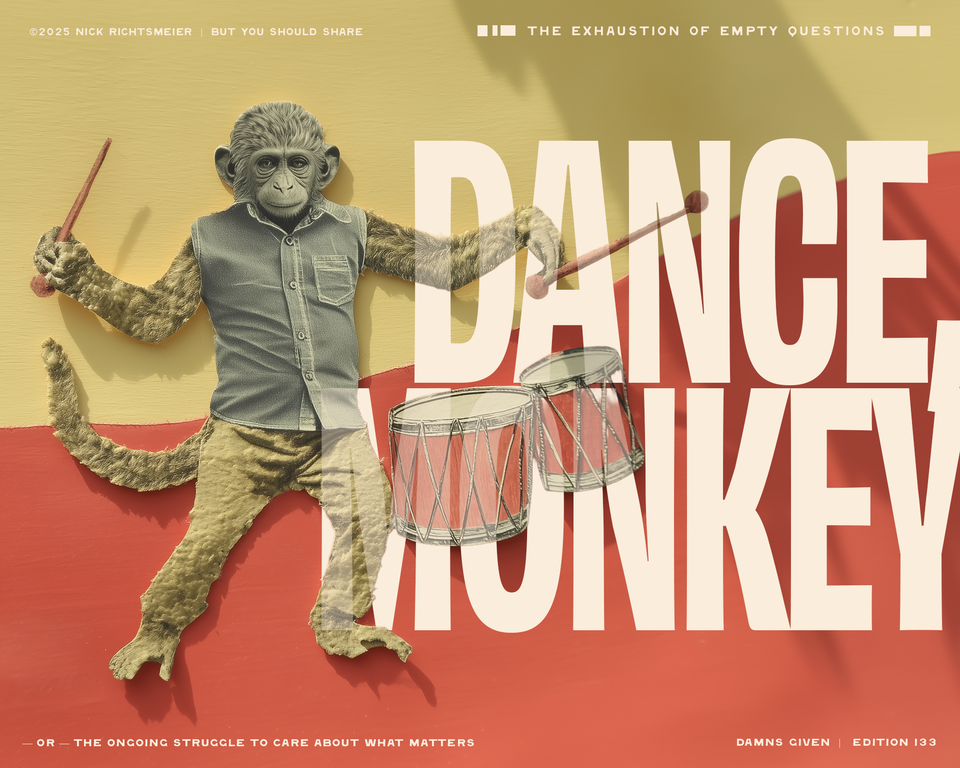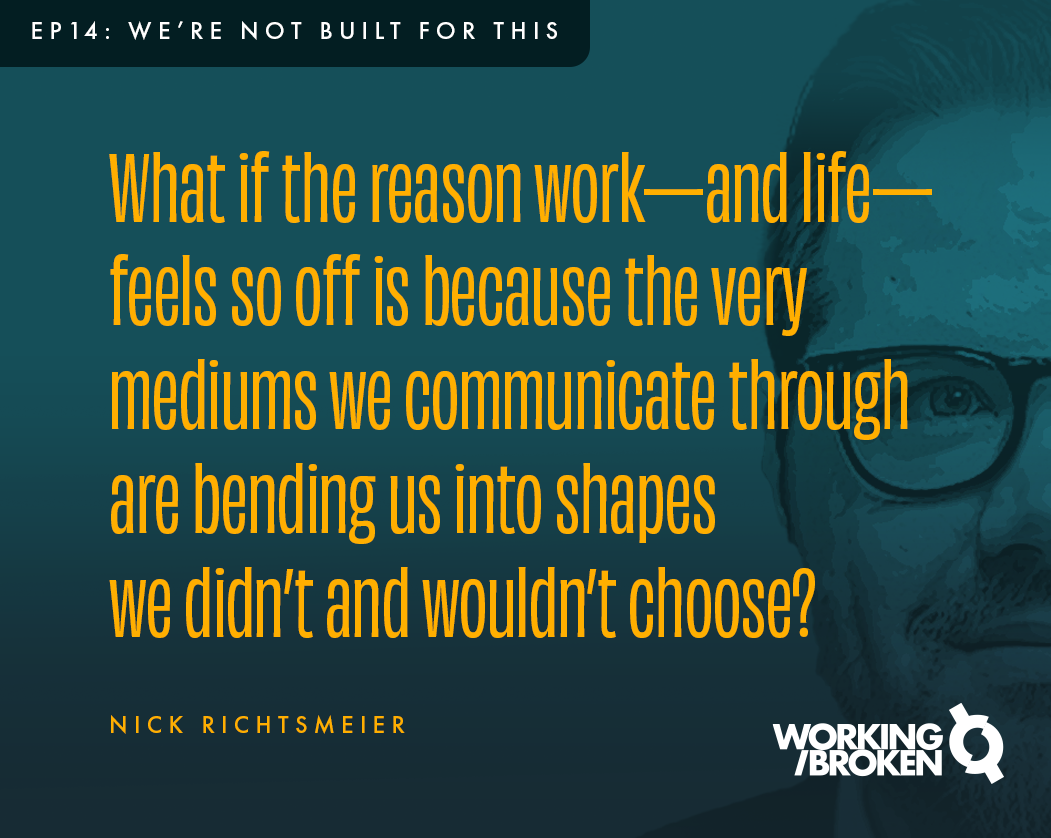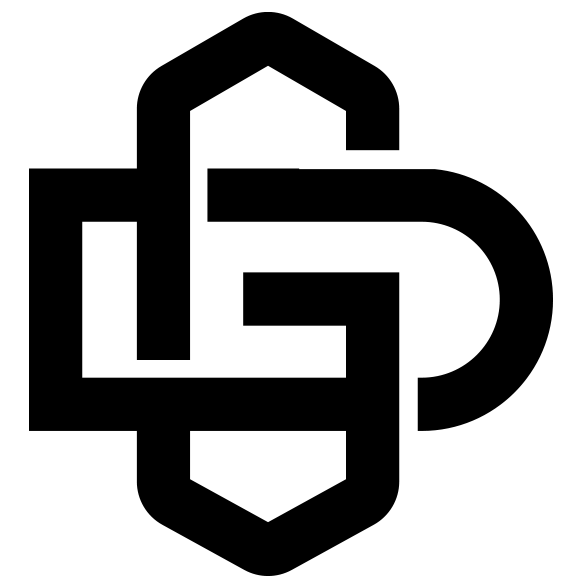
Edition 133 — OR — The ongoing struggle to care about what matters
Central to my work—across strategic growth for ventures, leadership coaching, mentorship, writing and everything in the cracks and crevices—is a question: what's worth caring about? Where should the damns be given now?
This question comes from half a lifetime of watching brilliant leaders succumb to the two extractive forces of work: urgency and salience. Leaders are surrounded by irritations that start to look like strategic problems if you stare at them long enough. They sap resources, attention, and eventually produce continental drift that makes should-be growing concerns icebergs at sea, slowly dissipating to global warming. Urgency becomes distraction, becomes disassociation, and fear management is shrouded in its Brooks Brothers suit: strategic planning.
Related, good leaders want escape velocity from the tyranny of the urgent. So they attend conferences. Join industry mastermind groups. Perservorate around category gurus who have been saying the same things with different keynote titles and higher speaking fees for twenty years. They know how to present the idea they had in 2010 about something like the "digitally empowered advisor" in a dozen different costumes, all while wearing the same stage uniform, because it's their brand.
These gurus and conference managers would never deign so low as to be accused of pandering trends, they are "looking around corners" and "seeing where the industry is going" and other such prognostications that do little but create homogenization at scale for industries already suffering under price compression and commodification.
Growth stops meaning development and earning new customers, it means scale and fat margins. Tactics move to cost-cutting-as-a-strategy and expansion by acquisition and assimilation. "What's good for our client?" slowly degrades into "What's good for our investor?" though no one would dare say such things out loud. Instead, we'll get the annual rotation of gurus writing the big think piece in the industry trade, "Ladies and gentlemen, we have an organic growth problem."
All of these are late-emerging side effects of trend-chasing, trying to find the truth of a venture "out there" instead of "in here" where it is always reliably bubbling up, waiting to engaged.
Anemic Questions Endure
When I was first accused of being a "Giver of Damns," it was, I think, a hybrid criticism/compliment (is there a portmanteau here? critliment? complicism? You tell me.) about my willingness on the LinkedIn hellscape to have a take on diverse topics. I was unwilling to stay in my lane. Of course, on LinkedIn you are supposed to put on your costume and perform for your late-stage capitalism overlords by being a one-line version of yourself which only speaks when spoken to or at most writes hyper-repetitive posts about the one thing you get paid money to do.
I am a bad monkey.

Caring about nothing but your own self-preservation and the scraps of attention economy offered to subsist upon is your required service. Platform media (I refuse to pretend anymore that what is happing there is social in any human way) demands of us algorithmic alignment, a shrinking of our psyches, a perpatetic chase of attention and clout. This shows up in the thousands of dollars firms are shelling out for more tech dashboards, the faulty data that feeds them, and the "oh well, that makes us feel better" dopamine hit that only a brightly colored chart you don't really understand can give.
But obsessing broadly instead of cornering myself in "do you need a new logo" or "how to convert your podcast to clients" distractions into all of the above, I was able to draw connections hiding in plain sight, readily ignored because they did not fit a convenient narrative. I learned in those days that the most anemic questions, the ones empty of power and grit, have the greatest longevity in a culture made by algorithms. If you want to think well you might go read book, ask a friend, dive into a deep thinking piece on somebody else's website. And Facebook wants you on Facebook. Google wants you on that Google page. LinkedIn wants you on LinkedIn, feeling vaguely that the world has passed you by, or you might as well scan a wall of vapid, self-congratulatory crap.
During Covid, this was about highlighting the rise of professional and advisory services as lifestyle brands. The world was stuck inside, and everything from our politics to our movies felt insular and derivative. It was not a prediction of the future to say that information access and analysis was stale but self-fulfillment was a mass market obsession.
2019-2021
We worked with advisor groups, legal firms, and community agencies to recenter themselves as practical stewards of the good life. This meant more than cheap stock photography of multi-generational beach running. This required a reframing of offering design, a deep specificity of client experience, and a transformation of even the concept of "client-centric which had been transmuted into a cover story for buying dashboard software.
Everyone was obsessed with maximizing web traffic with so many people trapped at home. The sad question of "how do we maximize all this available web traffic?" endured. But the signs were already rising: you can't eat web traffic, and in the end your obsession with it will eat you alive.

2022-2023
In the two years that followed, I watched as agencies and marketers grew ever more frantic to prove they had the technology to do what was no longer possible. We had worked with clients deeply embedded in the digital marketing fantasy and it was clear that Google, Meta and their intermediaries were going to keep raising costs, reducing benefits, and hiding more and more in the black box of "digital marketing magic." The trend was to buy more software, scrape more data, and accept the overhead by convincing yourself with enough content and advertising you could "create demand" out of nothing.
We saw something else: a fundamental rift between product, marketing, and sales that marketing was being asked to solve with ever-increasing cost and technological dependency. Marketing was framed as "sin eater" when what was really at stake was an organizational design problem of allocating power, budget, and responsibility. We started teaching execs how to hire and manage marketing teams. We started teaching marketers how to think like strategists and not button pushers. We ate our own cooking and got out of the agency business. It made no sense to continue to sell services built on assumptions that no longer applied.
I saw the question of "how can we get more leads on the internet?" to be so entrenched in the fantasies of business leaders and capital that they were willing to burn almost unlimited resources to keep this tired question centerstage.
It was time to give a damn about questioning the internet writ large.
2024-2025
For a year I researched, connected dots, dug deep into the religion that had become the internet. Personally, I also grappled with what I more-and-more saw as the death of something that had changed my life. I was an internet kid. Finding solace in the be-bong-biizzzz-bong-bi-bung-buzz of access to the world wide web. I had found community, an audience for my writing, most of my clients, and a world of brilliance on the internet. I was among those loudly clamoring for tech-powered superhumans in the middle 2010s. I'd called for the Uberization of everything on stages on both coasts.
So to address the possibility that this thing which had been central to my life's experience was, to say the least, daunting. I was drowning under the weight of the sunk cost fallacy.
And yet, everywhere I looked, the one thing worth caring about for our clients was the closing of the internet. When I first wrote "The Web-Ending Whimper," it was met with a lot of scoffs. Particularly from marketers. It didn't bother me. I didn't need to have all the right answers, I just needed to ask better questions. Then John and Hank Green, famous internet denizens, released their groundbreaking video The Internet is a Trust-Devouring Machine. Finally, validation.
We had for some time been building our IP and working around a framework I called Trust-Made Growth™, where the fundamentals that power salience and customer-attraction are recentered, decentering marketing as a discipline wrapped in bad incentives. The answer for most firms was less marketing. Or at least the anemic thing they called "marketing." The blog writing, and social media posting, and website fidgiting, and ad-buying. It was all burning time, attention, and credibility.
Now, we know more even than we did then. We know that the incentive structure and attention warping powers of AI-powered "social" media and search are throwing people into dymorphias of all kinds, accelerating mental health problems, and centralizing power in the hands of 1-2 megafirms. More than 80% of web-based advertising flows through Google in some way. This country has always oscillated between protecting culture and commerce from the bulldozer of monopoly and installing them as sources of power and capital. It doesn't take an investigative reporter to see where we are now.
So what to give a damn about now?
No sane person will tell you what the future holds. Uncertainties inundate us. Yet we do have some sense of themesthat have no incentive to abate:
- The enshittification of web platforms will continue to accelerate. Even Reddit and LinkedIn, long touted as having structural defenses against such things, are now overrun by AI slop, mass-produced empty content--forcing long-term power users to ask the question: what are we even still doing here?
- Organic growth will continue to move from wide to narrow. Playing into mass audience attention grabbing and content spamming will continue to waste resources, while ventures who get narrow, get close to the customer, and "get emotional" (a theme I keep coming back to with growing brands) will win the day.
- Analog is not a trend, its a reversion to the mean. You are starting to hear more and more people talk about the "trend" of in-person experiences, print materials, private communities, and other anti-web strategies. These are not trends. They are a predictable return to the human norm. The human brain and social network has millennia of genetic coding that says we are happiest and healthiest in relational networks of 150 people, where we engage in trades that are no more than two degrees of separation away, and that have some form of connection to our geography and/or personal narrative. History will look back on the two decades where the internet tried to rewire humans before it replaced humans with online bots, as a wild anomaly.
Extraction happens in mass and at a distance. Commerce happens up close.
If you want to test your firm's readiness for a reversion to the mean and the deplatforming of human attention, I suggest we grab a conversation. You'll like me better up close.
Stay brains on, heart open, forward progress.
